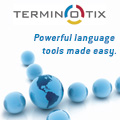| Most helpful review | Very powerful, flexible and user-friendly Logiterm is not a translation memory software in the strict sense insofar as it doesn’t memorize segments as you translate them. However, it is a very powerful and intuitive tool for leveraging past translations, documentation, glossaries, etc.
PROS
- The most accurate alignment engine out there.
- The most flexible and effective tool for accessing past translations that I have tried. You can add the most relevant and/or reliable previous translations and glossaries to the TM you use to pretranslate a doc but still access your entire corpus of past translations, related documents and glossaries in another window when editing and confirming the translation. You can search your entire corpus or specific parts of it, search full text or translation pairs, use search parameters, etc.
- Very easy to learn and easy to work with, especially when translating in Word. For Word, Logiterm installs a toolbar instead of forcing you to work in another environment. Past translation pairs with highlighted differences appear in a pop-up window for editing and are then entered directly in the Word document. I find it a much more natural and flexible way to translate than working in a TEnT. You can use the Logiterm pop-up window where you want, switch back to translating directly in Word where it makes more sense, continue accessing Logiterm’s search functions whenever you want. There are no formatting glitches caused by exporting the finished translation from the TEnT back to Word (except that inline codes must be added manually in Word). At the same time, Logiterm doesn’t have the severe limitations of the Wordfast Word add-on.
- The almost-free Logiterm toolbar makes it easy to share output with collaborators who don’t own Logiterm and lets them use and edit pretranslation results as effectively as owners of the software.
- Tech support is fast and helpful.
CONS
- Not nearly as good as MemoQ or other conventional TMs for translating a document with many internal repetitions but no similarity to past translations. Logiterm will identify 100% matches within a document and propagate your translation throughout the file but it can’t find internal fuzzy matches within a document.
- No QA function. If you want QA, you have to use a separate error-checking software. I use Verifika and in a way I don’t mind, since I find Verifika is much better than the built-in error checkers in other CAT tools anyway, but it is definitely a more cumbersome process.
- Terminotix is very slow to fix bugs. For example, Logiterm doesn’t process end-of-segment punctuation, just leaves it as is. So if a segment ends with a space followed by a colon or semi-colon, there is no way to remove the space in Logiterm. If a segment ends with a bracket, Logiterm leaves it there, even if you have moved the parentheses to inside the segment. You have to edit out unwanted end-of-segment punctuation in Word. This is not a huge problem since you have the Word screen in front of you as you translate in the Logiterm pop-up window, but Terminotix has known about this bug for years and definitely should have addressed it by now.
BOTTOM LINE
I have been using Logiterm as my main CAT tool for about 10 years and, despite some irritants, I still find it to be the smoothest CAT software to work with. After trying others periodically, I keep coming back to Logiterm because of its flexibility and ease of use.
UPDATE
Since I wrote this review, a new Logiterm release has fixed the bugs and added the ability to find and process fuzzy matches within a document.
So, at this point, the only situation in which I would still prefer memoQ to Logiterm is a large project with many internal repetitions that has to be divided among several translators. Logiterm has nothing comparable to the capabilities of memoQ's server edition. But for any one-man job, I think Logiterm is the cleaner solution now. 8 out of 8 found this review helpful.
Read more reviews → | Once Top of the Bill I've used Transit for about 15 years. I was once enthusiastic about it, now I think that Transit is no longer up to today's standards.
This tool has always been very expensive to buy. The file format filters are of high quality, but additional filters are expensive too. Other CAT tools offer these additional filters (FrameMaker MIF etc.) for free!
The learning curve is quite steep. The documentation is great.
Transit only supports XLIFF in *one* direction (import), which is quite unacceptable. It missis out on smart editing features like automatic case adaption during Find and Replace, auto-assembling etc. It's not possible to select the whole content of one segment (without defining a macro first) and to perform operations on that selection (like case toggling).
The Access or MS SQL databases that are used to store terminology, respond slow when more than about 500,000 entries are stored. Importing terminology can take a long time.
Support is quite expensive and doesn't always provide a solution.
Transit's tag handling is a real disaster. There are so many tags, many of them grouped, which makes it even harder to insert/move them. It's a dull task to insert the necessary tags. You have to be a keyboard magician, using all kinds of keyboard shortcuts.
By default, you have to overwrite the target text, instead of starting to type in an empty segment. You really have to like that (or not).
Personally, I let my Transit rest in a Virtual Machine and use another tool to process all Transit project files. One that lets me focus on the text at hand, instead on tags.13 out of 13 found this review helpful.
Read more reviews → |
| Product description | A COMPLETE TRANSLATION SOFTWARE COMBINING A FULL-TEXT SEARCH ENGINE WITH TRANSLATION, TERMINOLOGY, DATA CONVERSION AND ALIGNMENT TOOLS | Transit NXT is the next generation of STAR's translation memory system. This new version will offer an optimized solution to make your translation teams even more productive.
Translation Memory in Context: What Makes Transit Different?
The sentence is the basic unit of language. However it is not necessarily the basic unit of meaning. Translators read sentences in the source text, but are only able to do a good job of translating them if they are able to derive and understand their meaning from the context. This is a principle which was taken into account in the first version of Transit, over 20 years ago. In contrast to other translation memory systems, Transit does away with a database which is exclusively sentence based; instead the full breadth of the context contained in a document remains available in the Transit reference material. |





